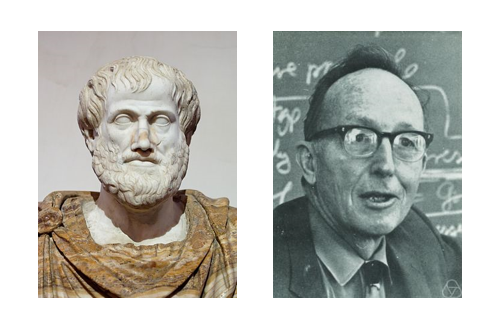Aaron Evans condensed a good deal of software engineering experience down to less than 140 characters:
It’s amazing how much cleaner your code looks the third time writing it. First time, hack; Second over-engineer; Third = goldilocks.
Aaron Evans condensed a good deal of software engineering experience down to less than 140 characters:
It’s amazing how much cleaner your code looks the third time writing it. First time, hack; Second over-engineer; Third = goldilocks.
From Saunders Mac Lane:
Now the discovery of ideas as general as these is chiefly the willingness to make a brash or speculative abstraction, in this case supported by the pleasure of purloining words from the philosophers: “Category” from Aristotle and Kant, “Functor’ from Carnap …, and “natural transformation” from the current informal parlance.

Related: Applied category theory
Michael Fogus posted on Twitter this morning
Computing: the only industry that becomes less mature as more time passes.
The immaturity of computing is used to excuse every ignorance. There’s an enormous body of existing wisdom but we don’t care.
I don’t know whether computing is becoming less mature, though it may very well be on average, even if individual developers become more mature.
One reason is that computing is a growing profession, so people are entering the field faster than they are leaving. That lowers average maturity.
Another reason is chronological snobbery, alluded to in Fogus’s second tweet. Chronological snobbery is pervasive in contemporary culture, but especially in computing. Tremendous hardware advances give the illusion that software development has advanced more than it has. What could I possibly learn from someone who programmed back when computers were 100x slower? Maybe a lot.
Sweave and Pweave are programs that let you embed R and Python code respectively into LaTeX files. You can display the source code, the result of running the code, or both.
lhs2TeX is roughly the Haskell analog of Sweave and Pweave. This post takes the sample code I wrote for Sweave and Pweave before and gives a lhs2TeX counterpart.
\documentclass{article}
%include polycode.fmt
%options ghci
\long\def\ignore#1{}
\begin{document}
Invisible code that sets the value of the variable $a$.
\ignore{
\begin{code}
a = 3.14
\end{code}
}
Visible code that sets $b$ and squares it.
(There doesn't seem to be a way to display the result of a block of code directly.
Seems you have to save the result and display it explicitly in an eval statement.)
\begin{code}
b = 3.15
c = b*b
\end{code}
$b^2$ = \eval{c}
Calling Haskell inline: $\sqrt{2} = \eval{sqrt 2}$
Recalling the variable $a$ set above: $a$ = \eval{a}.
\end{document}
If you save this code to a file foo.lhs, you can run
lhs2TeX -o foo.tex foo.lhs
to create a LaTeX file foo.tex which you could then compile with pdflatex.
One gotcha that I ran into is that your .lhs file must contain at least one code block, though the code block may be empty. You cannot just have code in \eval statements.
Unlike R and Python, the Haskell language itself has a notion of literate programming. Haskell specifies a format for literate comments. lhs2TeX is a popular tool for processing literate Haskell files but not the only one.
One of my favorite books when I was growing up was the Mathematics volume in the LIFE Science Library. I didn’t own the book, but my uncle did, and I’d browse through the book whenever I visited him. I was too young at the time to understand much of what I was reading.
One of the pages that stuck in my mind was a photo of Samuel Eilenberg. His name meant nothing to me at the time, but the caption titled “A subway topologist” caught my imagination.
… Polish-born Professor Samuel Eilenberg sprawls contemplatively in his Greenwich Village apartment in New York City. “Sometimes I like to think lying down,” he says, “but mostly I like to think riding on the subway.” Mainly he thinks about algebraic topology — a field so abstruse that even among mathematicians few understand it. …
I loved the image of Eilenberg staring intensely at the ceiling or riding around on a subway thinking about math. Since then I’ve often thought about math while moving around, though usually not on a subway. I’ve only lived for a few months in an area with a subway system.
The idea that a field of math would be unknown to many mathematicians sounded odd. I had no idea at the time that mathematicians specialized.
Algebraic topology doesn’t seem so abstruse now. It’s a routine graduate course and you might get an introduction to it in an undergraduate course. The book was published in 1963, and I suppose algebraic topology would have been more esoteric at the time.
I recently ran across PSReadLine, a project that makes the PowerShell console act more like a bash shell. I’ve just started using it, but it seems promising. I’m switching between Linux and Windows frequently these days and it’s nice to have a little more in common between the two.
I’d rather write a PowerShell script than a bash script, but I’d rather use the bash console interactively. The PowerShell console is essentially the old cmd.exe console. (I haven’t kept up with PowerShell in a while, so maybe there have been some improvements, but it’s my impression that the scripting language has moved forward and the console has not.) PSReadLine adds some bash-like console conveniences such as Emacs-like editing at the command prompt.
Update: Thanks to Will for pointing out Clink in the comments. Clink sounds like it may be even better than PSReadLine.

How many ways can you make change for a dollar? This post points to two approaches to the problem, one computational and one analytic.
SICP gives a Scheme program to solve the problem:
(define (count-change amount) (cc amount 5))
(define (cc amount kinds-of-coins)
(cond ((= amount 0) 1)
((or (< amount 0) (= kinds-of-coins 0)) 0)
(else (+ (cc amount
(- kinds-of-coins 1))
(cc (- amount
(first-denomination
kinds-of-coins))
kinds-of-coins)))))
(define (first-denomination kinds-of-coins)
(cond ((= kinds-of-coins 1) 1)
((= kinds-of-coins 2) 5)
((= kinds-of-coins 3) 10)
((= kinds-of-coins 4) 25)
((= kinds-of-coins 5) 50)))
Concrete Mathematics explains that the number of ways to make change for an amount of n cents is the coefficient of zn in the power series for the following:
Later on the book gives a more explicit but complicated formula for the coefficients.
Both show that there are 292 ways to make change for a dollar.
Jigsaw puzzles that say they have 1,000 pieces have approximately 1,000 pieces, but probably not exactly 1,000. Jigsaw puzzle pieces are typically arranged in a grid, so the number of pieces along a side has to be a divisor of the total number of pieces. This means there aren’t very many ways to make a puzzle with exactly 1,000 pieces, and most have awkward aspect ratios.

Since jigsaw pieces are irregularly shaped, it may be surprising to learn that the pieces are actually arranged in a regular grid. At least they usually are. There are exceptions such as circular puzzles or puzzles that throw in a couple small pieces that throw off the grid regularity.
How many aspect ratios can you have with a rectangular grid of 1,000 points? Which ratio comes closest to the golden ratio? More generally, answer the same questions with 10^n points for positive integer n.
More puzzles:
How much difference does the earth’s equatorial bulge make in its surface area?
To first approximation, the earth is a sphere. The next step in sophistication is to model the earth as an ellipsoid.
The surface area of an ellipsoid with semi-axes a ≥ b ≥ c is
where
and
The functions E and F are incomplete elliptic integrals
and
implemented in SciPy as ellipeinc and ellipkinc. Note that the SciPy functions take m as their second argument rather its square root k.
For the earth, a = b and so m = 1.
The following Python code computes the ratio of earth’s surface area as an ellipsoid to its area as a sphere.
from numpy import pi, sin, cos, arccos from scipy.special import ellipkinc, ellipeinc # values in meters based on GRS 80 # https://en.wikipedia.org/wiki/GRS_80 equatorial_radius = 6378137 polar_radius = 6356752.314140347 a = b = equatorial_radius c = polar_radius phi = arccos(c/a) # in general, m = (a**2 * (b**2 - c**2)) / (b**2 * (a**2 - c**2)) m = 1 temp = ellipeinc(phi, m)*sin(phi)**2 + ellipkinc(phi, m)*cos(phi)**2 ellipsoid_area = 2*pi*(c**2 + a*b*temp/sin(phi)) # sphere with radius equal to average of polar and equatorial r = 0.5*(a+c) sphere_area = 4*pi*r**2 print(ellipsoid_area/sphere_area)
This shows that the ellipsoid model leads to 0.112% more surface area relative to a sphere.
Source: See equation 19.33.2 here.
Update: It was suggested in the comments that it would be better to compare the ellipsoid area to that of a sphere of the same volume. So instead of using the average of the polar and equatorial radii, one would take the geometric mean of the polar radius and two copies of the equatorial radius. Using that radius, the ellipsoid has 0.0002% more area than the sphere.
Update 2: This post gives a simple but accurate approximation for the area of an ellipsoid.